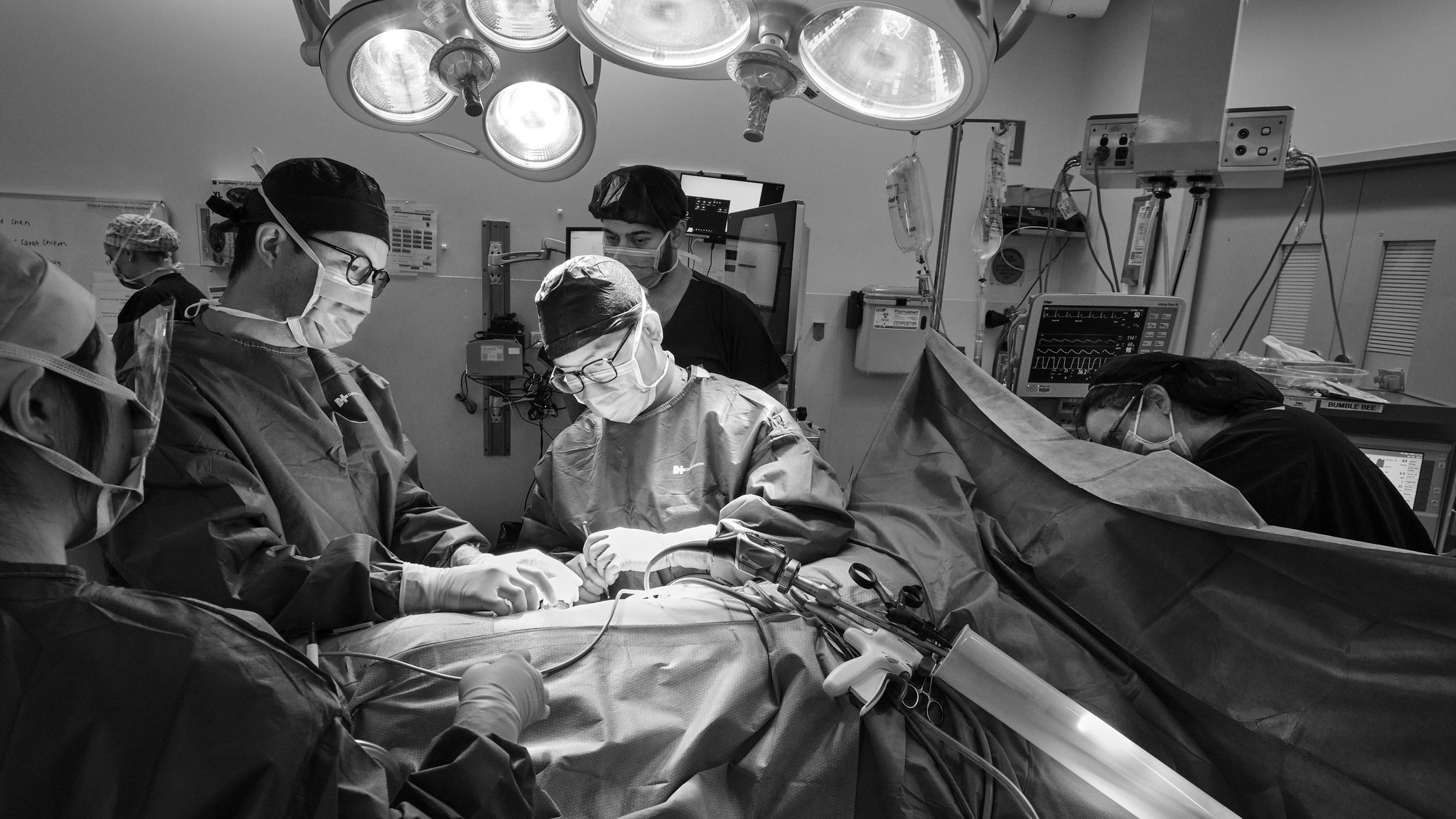
Melbourne man Steve Bruhn donated his kidney to a stranger so his wife of 43 years, Leanne, could receive a much-needed new kidney.
The couple were among 9 donors and 9 recipients to have sequential surgery over a few days as part of the Australian and New Zealand Paired Kidney Exchange (ANZKX) Program.
Steve and Leanne had their operations at Monash Medical Centre on the same day in September 2024.
Their experience is documented in a new photographic exhibition at the hospital in Clayton.
Capturing moments in time
At the start of the black and white photographic series, photographer Andew Chapman captures the couple in their Berwick lounge room days before their operations.
Boxes containing materials used for Leanne’s nightly dialysis can be seen piled in the background.
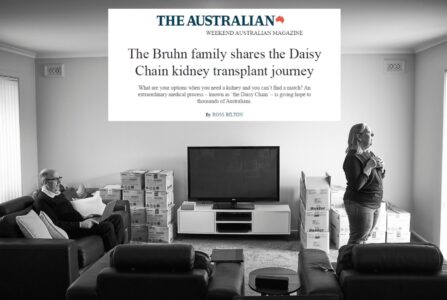
Steve and Leanne Bruhn’s story featured in the Weekend Australian Magazine.
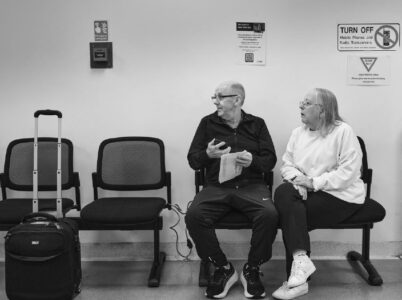
Steve and Leanne Bruhn sitting in a waiting room on the day of their operations.
At the hospital, Steve and Leanne can be seen preparing for, undergoing and recovering from surgery.
‘Steve went in first, at 8 am,’ Leanne told Weekend Australian Magazine.
‘Shortly before I went in for my mine at 2 pm I was told he’d come through it and was in recovery. It was a huge relief to know he was OK.’
The medical team involved in the couple’s care, including surgeons, anaesthetists, nurses and transplant coordinators, is photographed at work.
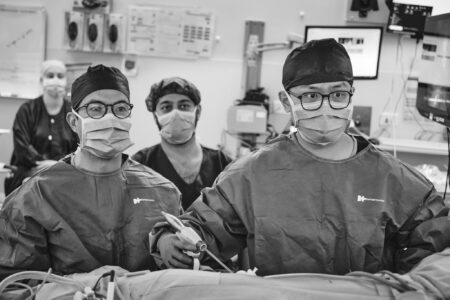
Surgeons David Soon and Aaron Hui during operation to remove Steve Bruhn’s kidney.
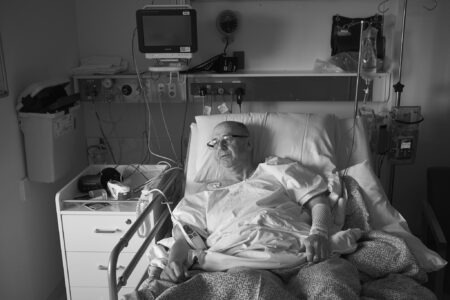
Live kidney donor Steve Bruhn recovering after surgery.
‘We are very grateful that Leanne and Steve allowed Andrew to chronicle their donation and transplant journey at Monash Medical Centre,’ said the Director of Nephrology at Monash Health, Professor John Kanellis.
‘It gives great insight into the process and hopefully helps promote organ donation.’
A subject close to home
Andrew Chapman is himself a recipient of two transplants.
The photographer received a lifesaving liver from a deceased donor in 2011 and, years later, a kidney from his daughter, Sarah.
‘You don’t expect to be borrowing an organ from your child,’ Andrew told Weekend Australian Magazine.
‘It was a difficult decision, as you can imagine – but the whole family wanted to do it. And it means I’m getting to see my 4 grandkids grow up, which brings me so much joy.’
Andrews hopes the GIVING LIFE exhibition will raise awareness of living kidney donation and motivate more people to join the Australian Organ Donor Register.
A team effort
The transplant service at Monash Health has grown significantly in size over the last 2 decades.
‘In our clinics, we now see approximately 150 patients every week who have a functioning donor kidney, or kidney and pancreas transplant,’ said Prof Kanellis.
‘We look after more than a thousand patients with transplants and perform 80 to 100 new transplant procedures every year.’
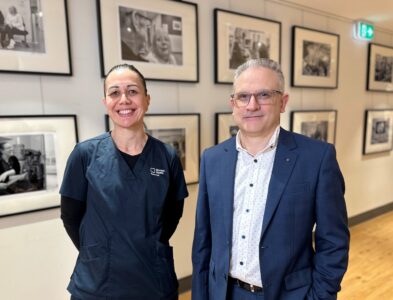
Transplant coordinator Tia Mark and Director of Nephrology, Prof John Kanellis.
‘The team of nurses, clerks, surgeons, physicians, and allied health staff – including a renal psychiatrist and psychologist – are very proud of this work as it leads to incredible benefits for patients and their families.’
‘It’s a massive team effort when one also considers the incredibly important roles played by others, including our operating theatre staff, anaesthetics department and our intensive care unit. Also, the constant efforts of the organ donor coordinators who liaise closely with the grieving families of those being assessed for deceased donation.’
A shortage of donors
There remains a major discrepancy between the demand for transplant organs and availability.
‘At present more than 1,000 people are awaiting a kidney transplant in Australia, and the typical waiting time on dialysis can be several years,’ said Prof Kanellis.
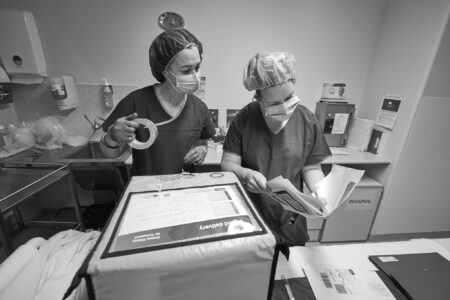
Transplant coordinators Tia Mark and Stephanie Loader preparing Steve Bruhn’s kidney for transport.
‘Live donation allows those with kidney failure to proceed more rapidly to a better life with a transplant and can even be performed before the need for dialysis.’
Where a would-be live donor finds they are incompatible with their intended recipient – as occurred in Steve and Leanne’s case – a successful donation and transplant may be achieved through the Australian and New Zealand Paired Kidney Exchange (ANZKX) Program.
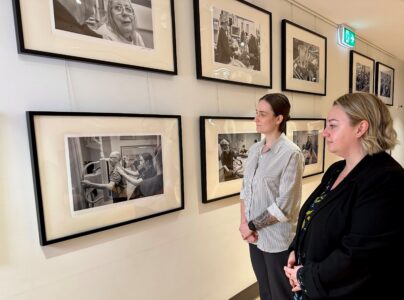
Donation specialist nurse coordinators Chelsea Harris and Jen Plummer at the exhibition.
The photos are on display in the corridors near Clinic O at Monash Medical Centre – close to the Aboriginal Healing Garden.


